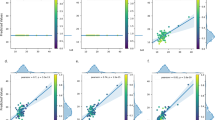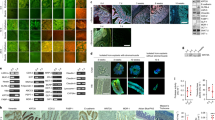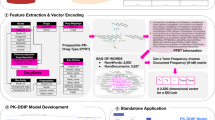Abstract
In vitro systems that accurately model in vivo conditions in the gastrointestinal tract may aid the development of oral drugs with greater bioavailability. Here we show that the interaction profiles between drugs and intestinal drug transporters can be obtained by modulating transporter expression in intact porcine tissue explants via the ultrasound-mediated delivery of small interfering RNAs and that the interaction profiles can be classified via a random forest model trained on the drug–transporter relationships. For 24 drugs with well-characterized drug–transporter interactions, the model achieved 100% concordance. For 28 clinical drugs and 22 investigational drugs, the model identified 58 unknown drug–transporter interactions, 7 of which (out of 8 tested) corresponded to drug-pharmacokinetic measurements in mice. We also validated the model’s predictions for interactions between doxycycline and four drugs (warfarin, tacrolimus, digoxin and levetiracetam) through an ex vivo perfusion assay and the analysis of pharmacologic data from patients. Screening drugs for their interactions with the intestinal transportome via tissue explants and machine learning may help to expedite drug development and the evaluation of drug safety.
This is a preview of subscription content, access via your institution
Access options
Access Nature and 54 other Nature Portfolio journals
Get Nature+, our best-value online-access subscription
$29.99 / 30 days
cancel any time
Subscribe to this journal
Receive 12 digital issues and online access to articles
$99.00 per year
only $8.25 per issue
Buy this article
- Purchase on Springer Link
- Instant access to full article PDF
Prices may be subject to local taxes which are calculated during checkout





Similar content being viewed by others
Data availability
The raw and analysed datasets generated during the study are available for research purposes from the corresponding author on reasonable request.
Code availability
All training data and code used for machine learning and to make predictions are available on GitHub at https://github.com/RekerLab/Transportome.
References
DeGorter, M. K., Xia, C. Q., Yang, J. J. & Kim, R. B. Drug transporters in drug efficacy and toxicity. Annu. Rev. Pharmacol. Toxicol. 52, 249–273 (2012).
Nigam, S. K. What do drug transporters really do? Nat. Rev. Drug Discov. 14, 29–44 (2015).
Shitara, Y., Horie, T. & Sugiyama, Y. Transporters as a determinant of drug clearance and tissue distribution. Eur. J. Pharm. Sci. 27, 425–446 (2006).
Huang, Y. et al. Membrane transporters and channels: role of the transportome in cancer chemosensitivity and chemoresistance. Cancer Res. 64, 4294–4301 (2004).
Brouwer, K. L. et al. In vitro methods to support transporter evaluation in drug discovery and development. Clin. Pharmacol. Ther. 94, 95–112 (2013).
Fekete, Z. et al. Membrane assays to characterize interaction of drugs with ABCB1. J. Membr. Biol. 248, 967–977 (2015).
International Transporter, C. et al. Membrane transporters in drug development. Nat. Rev. Drug Discov. 9, 215–236 (2010).
Pratt, J. et al. Use of zinc finger nuclease technology to knock out efflux transporters in C2BBe1 cells. Curr. Protoc. Toxicol. 23, Unit 23.2 (2012).
Sampson, K. E. et al. Zinc finger nuclease-mediated gene knockout results in loss of transport activity for P-glycoprotein, BCRP, and MRP2 in Caco-2 cells. Drug Metab. Dispos. 43, 199–207 (2015).
Balimane, P. V. & Chong, S. Cell culture-based models for intestinal permeability: a critique. Drug Discov. Today 10, 335–343 (2005).
Ingels, F. M. & Augustijns, P. F. Biological, pharmaceutical, and analytical considerations with respect to the transport media used in the absorption screening system, Caco-2. J. Pharm. Sci. 92, 1545–1558 (2003).
Fagerholm, U. Prediction of human pharmacokinetics—gastrointestinal absorption. J. Pharm. Pharmacol. 59, 905–916 (2007).
Sun, D. et al. Comparison of human duodenum and Caco-2 gene expression profiles for 12,000 gene sequences tags and correlation with permeability of 26 drugs. Pharm. Res. 19, 1400–1416 (2002).
Teksin, Z. S., Seo, P. R. & Polli, J. E. Comparison of drug permeabilities and BCS classification: three lipid-component PAMPA system method versus Caco-2 monolayers. AAPS J. 12, 238–241 (2010).
Musther, H., Olivares-Morales, A., Hatley, O. J., Liu, B. & Rostami Hodjegan, A. Animal versus human oral drug bioavailability: do they correlate? Eur. J. Pharm. Sci. 57, 280–291 (2014).
Kim, Y. & Chen, J. Molecular structure of human P-glycoprotein in the ATP-bound, outward-facing conformation. Science 359, 915–919 (2018).
Aniceto, N., Freitas, A. A., Bender, A. & Ghafourian, T. Simultaneous prediction of four ATP-binding cassette transporters’ substrates using multi-label QSAR. Mol. Inform. 35, 514–528 (2016).
Sedykh, A. et al. Human intestinal transporter database: QSAR modeling and virtual profiling of drug uptake, efflux and interactions. Pharm. Res. 30, 996–1007 (2013).
Karlgren, M. et al. In vitro and in silico strategies to identify OATP1B1 inhibitors and predict clinical drug–drug interactions. Pharm. Res. 29, 411–426 (2012).
Jain, S. & Ecker, G. F. In silico approaches to predict drug–transporter interaction profiles: data mining, model generation, and link to cholestasis. Methods Mol. Biol. 1981, 383–396 (2019).
Bhhatarai, B., Walters, W. P., Hop, C., Lanza, G. & Ekins, S. Opportunities and challenges using artificial intelligence in ADME/Tox. Nat. Mater. 18, 418–422 (2019).
Reker, D. Practical considerations for active machine learning in drug discovery. Drug Discov. Today Technol. 32–33, 73–79 (2019).
Montanari, F. & Ecker, G. F. Prediction of drug–ABC-transporter interaction—recent advances and future challenges. Adv. Drug Deliv. Rev. 86, 17–26 (2015).
Clerbaux, L. A. et al. Capturing the applicability of in vitro–in silico membrane transporter data in chemical risk assessment and biomedical research. Sci. Total Environ. 645, 97–108 (2018).
Gonzalez, L. M., Moeser, A. J. & Blikslager, A. T. Porcine models of digestive disease: the future of large animal translational research. Transl. Res 166, 12–27 (2015).
Henze, L. J. et al. The pig as a preclinical model for predicting oral bioavailability and in vivo performance of pharmaceutical oral dosage forms: a PEARRL review. J. Pharm. Pharmacol. 1, 581–602 (2018).
Singh, V. K., Thrall, K. D. & Hauer-Jensen, M. Minipigs as models in drug discovery. Expert Opin. Drug Discov. 11, 1131–1134 (2016).
von Erlach, T. et al. Robotically handled whole-tissue culture system for the screening of oral drug formulations. Nat. Biomed. Eng. 4, 544–559 (2020).
Pietzonka, P., Walter, E., Duda-Johner, S., Langguth, P. & Merkle, H. P. Compromised integrity of excised porcine intestinal epithelium obtained from the abattoir affects the outcome of in vitro particle uptake studies. Eur. J. Pharm. Sci. 15, 39–47 (2002).
Neirinckx, E. et al. Feasibility of the Ussing chamber technique for the determination of in vitro jejunal permeability of passively absorbed compounds in different animal species. J. Vet. Pharm. Ther. 34, 290–297 (2011).
Westerhout, J. et al. A new approach to predict human intestinal absorption using porcine intestinal tissue and biorelevant matrices. Eur. J. Pharm. Sci. 63, 167–177 (2014).
Gerber, W., Hamman, J. H. & Steyn, J. D. Excipient–drug pharmacokinetic interactions: effect of disintegrants on efflux across excised pig intestinal tissues. J. Food Drug Anal. 26, S115–S124 (2018).
Arnold, Y. E. & Kalia, Y. N. Using ex vivo porcine jejunum to identify membrane transporter substrates: a screening tool for early-stage drug development. Biomedicines 8, 340 (2020).
Arnold, Y. E., Thorens, J., Bernard, S. & Kalia, Y. N. Drug transport across porcine intestine using an Ussing chamber system: regional differences and the effect of P-glycoprotein and CYP3A4 activity on drug absorption. Pharmaceutics 11, 139 (2019).
Wishart, D. S. et al. DrugBank 5.0: a major update to the DrugBank database for 2018. Nucleic Acids Res. 46, D1074–D1082 (2018).
Haimeur, A., Conseil, G., Deeley, R. G. & Cole, S. P. The MRP-related and BCRP/ABCG2 multidrug resistance proteins: biology, substrate specificity and regulation. Curr. Drug Metab. 5, 21–53 (2004).
Johnson, Z. L. & Chen, J. Structural basis of substrate recognition by the multidrug resistance protein MRP1. Cell 168, 1075–1085 e1079 (2017).
Englund, G. et al. Regional levels of drug transporters along the human intestinal tract: co-expression of ABC and SLC transporters and comparison with Caco-2 cells. Eur. J. Pharm. Sci. 29, 269–277 (2006).
Kunta, J. R. & Sinko, P. J. Intestinal drug transporters: in vivo function and clinical importance. Curr. Drug Metab. 5, 109–124 (2004).
Estudante, M., Morais, J. G., Soveral, G. & Benet, L. Z. Intestinal drug transporters: an overview. Adv. Drug Deliv. Rev. 65, 1340–1356 (2013).
Van Peer, E. et al. Ontogeny of CYP3A and P-glycoprotein in the liver and the small intestine of the Gottingen minipig: an immunohistochemical evaluation. Basic Clin. Pharmacol. Toxicol. 114, 387–394 (2014).
Tang, H., Pak, Y. & Mayersohn, M. Protein expression pattern of P-glycoprotein along the gastrointestinal tract of the Yucatan micropig. J. Biochem. Mol. Toxicol. 18, 18–22 (2004).
Mouly, S. & Paine, M. F. P-glycoprotein increases from proximal to distal regions of human small intestine. Pharm. Res. 20, 1595–1599 (2003).
Tang, H. & Mayersohn, M. Porcine prediction of pharmacokinetic parameters in people: a pig in a poke?Drug Metab. Dispos. 46, 1712–1724 (2018).
Schoellhammer, C. M. et al. Ultrasound-mediated delivery of RNA to colonic mucosa of live mice. Gastroenterology 152, 1151–1160 (2017).
Schoellhammer, C. M. & Traverso, G. Low-frequency ultrasound for drug delivery in the gastrointestinal tract. Expert Opin. Drug Deliv. 13, 1045–1048 (2016).
Konig, J., Muller, F. & Fromm, M. F. Transporters and drug–drug interactions: important determinants of drug disposition and effects. Pharm. Rev. 65, 944–966 (2013).
FDA. Drug Development and Drug Interactions (US Food and Drug, 2019); https://www.fda.gov/Drugs/DevelopmentApprovalProcess/DevelopmentResources/DrugInteractionsLabeling/ucm093664.htm
Shugarts, S. & Benet, L. Z. The role of transporters in the pharmacokinetics of orally administered drugs. Pharm. Res. 26, 2039–2054 (2009).
Mak, L. et al. Metrabase: a cheminformatics and bioinformatics database for small molecule transporter data analysis and (Q)SAR modeling. J. Cheminform 7, 31 (2015).
Szakacs, G. et al. Predicting drug sensitivity and resistance: profiling ABC transporter genes in cancer cells. Cancer Cell 6, 129–137 (2004).
Wallqvist, A., Rabow, A. A., Shoemaker, R. H., Sausville, E. A. & Covell, D. G. Linking the growth inhibition response from the National Cancer Institute’s anticancer screen to gene expression levels and other molecular target data. Bioinformatics 19, 2212–2224 (2003).
Reker, D., Schneider, P., Schneider, G. & Brown, J. B. Active learning for computational chemogenomics. Future Med. Chem. 9, 381–402 (2017).
Reker, D., Schneider, P. & Schneider, G. Multi-objective active machine learning rapidly improves structure–activity models and reveals new protein–protein interaction inhibitors. Chem. Sci. 7, 3919–3927 (2016).
Amin, M. L. P-glycoprotein inhibition for optimal drug delivery. Drug Target Insights 7, 27–34 (2013).
Lemos, C., Jansen, G. & Peters, G. J. Drug transporters: recent advances concerning BCRP and tyrosine kinase inhibitors. Br. J. Cancer 98, 857–862 (2008).
Houghton, P. J. et al. Imatinib mesylate is a potent inhibitor of the ABCG2 (BCRP) transporter and reverses resistance to topotecan and SN-38 in vitro. Cancer Res. 64, 2333–2337 (2004).
Horikawa, M., Kato, Y., Tyson, C. A. & Sugiyama, Y. The potential for an interaction between MRP2 (ABCC2) and various therapeutic agents: probenecid as a candidate inhibitor of the biliary excretion of irinotecan metabolites. Drug Metab. Pharmacokinet. 17, 23–33 (2002).
Kim, K. A., Oh, S. O., Park, P. W. & Park, J. Y. Effect of probenecid on the pharmacokinetics of carbamazepine in healthy subjects. Eur. J. Clin. Pharm. 61, 275–280 (2005).
Gupta, A. et al. Cyclosporin A, tacrolimus and sirolimus are potent inhibitors of the human breast cancer resistance protein (ABCG2) and reverse resistance to mitoxantrone and topotecan. Cancer Chemother. Pharmacol. 58, 374–383 (2006).
Poller, B., Wagenaar, E., Tang, S. C. & Schinkel, A. H. Double-transduced MDCKII cells to study human P-glycoprotein (ABCB1) and breast cancer resistance protein (ABCG2) interplay in drug transport across the blood–brain barrier. Mol. Pharm. 8, 571–582 (2011).
Lai, Y. et al. Preclinical and clinical evidence for the collaborative transport and renal secretion of an oxazolidinone antibiotic by organic anion transporter 3 (OAT3/SLC22A8) and multidrug and toxin extrusion protein 1 (MATE1/SLC47A1). J. Pharmacol. Exp. Ther. 334, 936–944 (2010).
Mu, J. et al. Multiple transporters associated with malaria parasite responses to chloroquine and quinine. Mol. Microbiol. 49, 977–989 (2003).
Endres, C. J., Hsiao, P., Chung, F. S. & Unadkat, J. D. The role of transporters in drug interactions. Eur. J. Pharm. Sci. 27, 501–517 (2006).
Noe, J., Portmann, R., Brun, M. E. & Funk, C. Substrate-dependent drug–drug interactions between gemfibrozil, fluvastatin and other organic anion-transporting peptide (OATP) substrates on OATP1B1, OATP2B1, and OATP1B3. Drug Metab. Dispos. 35, 1308–1314 (2007).
Ichihara, S. et al. Association of a polymorphism of ABCB1 with obesity in Japanese individuals. Genomics 91, 512–516 (2008).
Acknowledgements
D.R. is a Swiss National Science Foundation Fellow (grant P2EZP3_168827 and P300P2_177833). This work was in part supported by NIH grant EB000244 (G.T., R.L.), the Karl van Tassel (1925) Career Development Professorship and Department of Mechanical Engineering MIT and Division of Gastroenterology, Brigham and Women’s Hospital (G.T.). The clinical work was in part supported by a Prostate Cancer Foundation Young Investigator Award (J.D.B.). Z.F. is supported by the Department of Defense through the National Defense Science and Engineering Graduate Fellowship Program. Z.Z. is supported by a Fellowship from the Department of Biomedical Engineering at Duke University. The authors acknowledge the use of resources of Microscopy Core Facilities at Swanson Biotechnology Center, David H. Koch Institute for Integrative Cancer Research at MIT, and G. Church for sharing the cell line PK15. The authors also acknowledge Partners RPDR team for their assistance with identifying patients and M. Jimenez for his substantial contributions to editing the manuscript.
Author information
Authors and Affiliations
Contributions
Y.S., D.R., J.D.B., A.R.K. and G.T. conceived the study, designed experiments and analysed data. K.H., Z.W., N.N., Z.F., Z.Z., A.L., V.S., J.W., T.v.E., C.C.Y. and L.M. performed experiments and analysed data. Y.S., D.R., J.D.B., A.R.K. and G.T. wrote the manuscript. R.L. and G.T. supervised the study. All authors discussed the results and assisted in the preparation of the manuscript.
Corresponding author
Ethics declarations
Competing interests
Y.S., D.R., V.S., R.L. and G.T. are co-inventors on a provisional patent application encompassing the work described. T.v.E., R.L. and G.T. have a financial interest in Vivtex, a biotechnology company applying ex vivo models for high-throughput drug formulation development. D.R. acts as a consultant to the pharmaceutical and biotechnology industry. Complete details of all relationships for profit and not for profit for G.T. and for R.L. can be found in the Supplementary Information.
Peer review
Peer review information
Nature Biomedical Engineering thanks Alexander Tropsha and the other, anonymous, reviewer(s) for their contribution to the peer review of this work.
Additional information
Publisher’s note Springer Nature remains neutral with regard to jurisdictional claims in published maps and institutional affiliations.
Extended data
Extended Data Fig. 1 Tissue viability assay and H&E histology staining to assess the safety and toxicity effect of ex vivo culture and low-frequency ultrasound on pig small intestine.
ATP and CellTiter-Glo assay were performed on ex vivo tissue cultured tissue with different time points to monitor the metabolic activity (a) and viability (b) of sliced tissue. c) ATP assay on ex vivo tissue at different ultrasound conditions to monitor damage caused by ultrasound delivery. d) TEER and FITC-labeled Dextran permeability assays to evaluate the possibility for changes in tissue permeability in response to low-frequency ultrasound treatment. In all experiments, three separate animal tissues were included and four repeats were performed for each tissue (n = 12). e) H&E histology staining using fresh tissue, tissue after a short ultrasound treatment, and tissue after a prolonged ultrasound treatment.
Extended Data Fig. 2 Validation of the ex vivo system for fold decrease of substrates/non-substrates of PEPT1 (A) and MCT1 (B) through the siRNA-mediated knock down of drug transporters of GI-TRIS.
Perfusion decreases for substrates because these enzymes are influx transporters.
Extended Data Fig. 3 Original data for substrate perfusion with siRNA treatment in the ex vivo system.
For each drug, the data is collected from 62–72 trials (n = 62–72) of tissue in four different pigs (m = 4). For siP-gp treated samples, Colchicine, Irinotecan, Loperamide, Nicardipine and Ranitidine are drug transporter specific substrates, while Carbamazepine, Chlorpheniramine, and Doxorubicin are non-specific substrates. For siBCRP treated samples, 4-methylumbelliferone sulfate, Daunorubicin, Mitoxantrone, Pitavastatin, and Rosuvastatin are BCRP specific substrates, while Doxorubicin, LysoTracker Green, and Rhodamine 123 are non-specific substrates. For siMRP2 treated samples, Etoposide, Irinotecan, Olmesartan, Para-aminohippurate, and Valsartan are MRP2 specific substrates, while Colchicine, Digoxin, and Nitrofurantoin are non-specific substrates.
Supplementary information
Supplementary Information
Supplementary results, methods, figures, tables and references.
Rights and permissions
Springer Nature or its licensor (e.g. a society or other partner) holds exclusive rights to this article under a publishing agreement with the author(s) or other rightsholder(s); author self-archiving of the accepted manuscript version of this article is solely governed by the terms of such publishing agreement and applicable law.
About this article
Cite this article
Shi, Y., Reker, D., Byrne, J.D. et al. Screening oral drugs for their interactions with the intestinal transportome via porcine tissue explants and machine learning. Nat. Biomed. Eng 8, 278–290 (2024). https://doi.org/10.1038/s41551-023-01128-9
Received:
Accepted:
Published:
Issue Date:
DOI: https://doi.org/10.1038/s41551-023-01128-9



